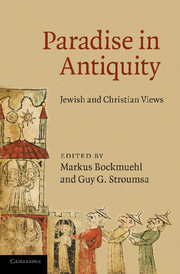Book contents
- Frontmatter
- Contents
- Notes on contributors
- 1 Introduction: the paradise chronotrope
- PART I PARADISES OF SECOND TEMPLE JUDAISM AND CHRISTIAN ORIGINS
- 2 The messiah in the garden: John 19.38–41, (royal) gardens, and messianic concepts
- 3 Philo's scholarly inquiries into the story of paradise
- 4 Paradise in the Biblical Antiquities of Pseudo-Philo
- 5 Paradise, gardens, and the afterlife in the first century ce
- 6 Paradise in the New Testament
- 7 Quis et unde? Heavenly obstacles in Gos. Thom. 50 and related literature
- PART II CONTEMPORIZING PARADISE IN LATE ANTIQUITY
- 15 Epilogue: a heaven on earth
- Select bibliography
- Index of subjects
- Index of authors (cited in text)
- Index of sources
5 - Paradise, gardens, and the afterlife in the first century ce
Published online by Cambridge University Press: 06 December 2010
- Frontmatter
- Contents
- Notes on contributors
- 1 Introduction: the paradise chronotrope
- PART I PARADISES OF SECOND TEMPLE JUDAISM AND CHRISTIAN ORIGINS
- 2 The messiah in the garden: John 19.38–41, (royal) gardens, and messianic concepts
- 3 Philo's scholarly inquiries into the story of paradise
- 4 Paradise in the Biblical Antiquities of Pseudo-Philo
- 5 Paradise, gardens, and the afterlife in the first century ce
- 6 Paradise in the New Testament
- 7 Quis et unde? Heavenly obstacles in Gos. Thom. 50 and related literature
- PART II CONTEMPORIZING PARADISE IN LATE ANTIQUITY
- 15 Epilogue: a heaven on earth
- Select bibliography
- Index of subjects
- Index of authors (cited in text)
- Index of sources
Summary
When contemporary rabbinic Jews think of the fate of the deceased righteous, they like to imagine them enjoying eternal life in the Garden of Eden, a notion already attested in the targumim in late antiquity. But although the historian Josephus referred in his Jewish Antiquities to the garden (kèpos) to which Adam and Eve were brought just after the creation of the world as a paradeisos (Ant. 1.37), using the same term for Eden as the Septuagint translators of Genesis (LXX Gen. 2.8), he made no reference in any of his works to a Jewish hope for a future existence there. The later rabbinic notion presumably did not spring from a vacuum, and the silence of Josephus therefore bears examination.
That paradeisos could refer in Josephus' day to more than either just a normal park or the primordial Garden of Eden is clear from the use of the term in the New Testament, where it bears at least three other connotations. One of these relates directly to paradise as the place where some will go after death, for Jesus is portrayed by Luke as reassuring one of the thieves crucified next to him that “today you will be with me in the paradeisos” (Luke 23.43). Perhaps different is the notion behind the claim in 2 Corinthians by Paul, when he was “caught up to the third heaven,” that he “was caught up to paradise and heard things that are not to be told” (2 Cor. 12.2, 4).
- Type
- Chapter
- Information
- Paradise in AntiquityJewish and Christian Views, pp. 57 - 63Publisher: Cambridge University PressPrint publication year: 2010
- 1
- Cited by



